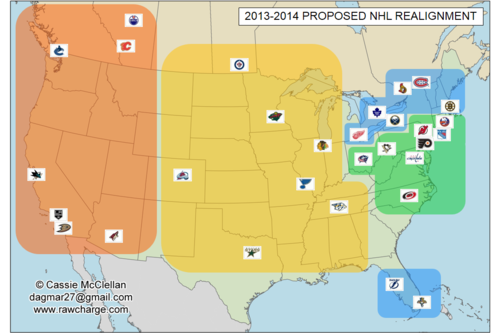
This past week there were many reports indicating that the NHL will soon announce a four division realignment plan as opposed to just swapping Winnipeg for Detroit, Columbus, or Nashville.
As you can see above with this great map, the realignment plan will consist of 16 teams in the East and 14 teams in the West. The scheduling plan is for division opponents to play each other four times a season and the rest of the league at least twice a year.
Here are some pros and cons to go with this new plan.
Pros
Red Wings To The East
The Red Wings have long complained to NHL HQ about travel woes and the desire to move to the East. Until now, the NHL has never really had any reason to consider swapping the Red Wings for another team.
Obviously the benefit for Detroit would be less late games and a lighter travel schedule, but the NHL could also boost ratings by rehashing old rivalries with the other Original 6 teams (minus Chicago), not to mention more games against the Flyers, Penguins and the Capitals.
Another benefit is a likely boost in attendance figures in Carolina and the two Florida teams. While those teams have drawn well the last 2 seasons, this is just another mini-game plan they can sell at a premium price.
Blue Jackets To The East
The Blue Jackets don’t bring the promise of boosting other team’s ratings and attendances, but they will get a boost themselves. The Jackets would obviously benefit at the gate (which they need) from seeing Crosby, Ovie and Nash more frequently and they could gain more exposure nationally as a result.
If you work for the CBJ’s marketing department, you are probably salivating at the chance to create ticket plans around Original 6 teams, Atlantic teams, all the while maintaining your geographic rival with Detroit.
Cons
Blackhawks lose a rival
Of course the drawback of Detroit moving east would be the demise of the Blackhawks/Red Wings rivalry, which would leave the Western Conference with zero rivalries for NBC Sports to milk. Sure the inter-California rivalries are great for growing hockey in the silicone state, but as far as national TV ratings go – they don’t move the dial.
Hopefully the Avalanche, St. Blues and Minnesota Wild can take the next step from a competitive standpoint. The Wild certainly have marketable players and St. Louis – in my qualitative opinion – is one of the best sports towns in the country. Hopefully they can fill the void left by Detroit.
More travel for the Bolts and Panthers
It is kind of odd the Lightning and the Panthers will have to fly over the new “Atlantic” division to get to their own division rivals, not to mention the increased travel costs. However, you would think that the additional travel costs will be offset by increased attendance figures in their respective arenas now that they will be playing Original 6 teams more frequently.
Of course, that’s just my theory. Hopefully someone at the NHL did some financial analysis and forecasting to see if that’s true. But then again, this is the NHL we are talking about.
Undecided
At first glance, the playoff format favors the Western conference. Eight out of 14 teams make the playoffs in the West, while eight out of 16 teams make the playoffs in the East. From a competitive standpoint, this seems unfair.
With that said, relocation and expansion is going to happen sooner rather than later. I’ve been talking about getting a team in Seattle for years. The one thing holding them back was a government unwilling to plunk down some dollars on a new arena. That’s changed recently and it’s only a matter of time before the NHL capitalizes and sets up shop.
At the end of the day, you will probably see a lift in the ratings and attendance figures. When those two things go up, the old saying rings true. “A rising tide lifts all ships.”
Share:
More About:Business of Hockey
